Mark Sisson's Blog, page 300
May 11, 2014
Weekend Link Love
 Jordan Reasoner and Steven Wright of SolvingLeakyGut.com
and authors of the book Surviving to Thriving are holding the second and final free webinar on how to heal leaky gut this coming Tuesday night, May 13, at 9 pm EDT. Register here to attend.
Jordan Reasoner and Steven Wright of SolvingLeakyGut.com
and authors of the book Surviving to Thriving are holding the second and final free webinar on how to heal leaky gut this coming Tuesday night, May 13, at 9 pm EDT. Register here to attend.
The Reversing Diabetes World Summit is on through May 16, so there’s still time to register and get six days of presentations for free.
Episode #18 of The Primal Blueprint Podcast is now live. I continue the thread from last week’s discussion of human performance by exploring the realities, controversies, and motivations behind the use of performance enhancing drugs. If you have any ideas for future podcasts, please let me know by using the blue “Submit a Question” button in the sidebar!
Research of the Week
Kids who play 5-10 hours outdoors each week are more likely to report having a spiritual connection to nature. Imagine what’d happen if everyone spent most of their time outside.
Average lifespan shot up in Europe following the Black Death, suggesting that the plague may have been a natural selection event that weeded out the less healthy and selected for the more robust.
Low-dose psilocybin inhibits the processing of negative emotions like anxiety and fear in the brain, a finding that could have clinical significance for depressed patients with excessive and debilitating processing of these negative emotions.
Experienced meditators can consciously control their sympathetic nervous system and immune response.
CLA-enriched dairy fat (also known as grass-fed butter in some circles) improves the metabolic profile of healthy young adults.
Interesting Blog Posts
The doctor who coined the term RICE (rest, ice, compress, elevate) back in the late 70s now recommends that injuries instead be treated with MCE (move, compress, elevate).
Why red meat might appear to be unhealthy in studies.
Why fear of saturated fat is so hard to shake.
Media, Schmedia
If it was directed to MDA readers, the article would be called “Everything you know about fat is right.”
The new “eat the whole animal” trend in high-end dining has a problem: many diners just want steak.
Everything Else
Vampire mice (sorta).
Should women be taking so many statins?
The lunch break is dying in America.
Pricier food tastes better, or at least we think it does. Is there a difference?
Recipe Corner
I’ve always preferred spare ribs to baby back ribs, so I think I’ll try these Hawaiian spare ribs.
Carrot fries, made in the oven.
Time Capsule
One year ago (May 11 – May 17)
7 Characteristics Associated with Long Life (and How to Cultivate Them) – What do the long-lived do, how do they think, and what sets them apart?
Why It’s Important to Cook Your Own Meals – There’s more to food than just the nutritional content.
Comment of the Week
I don’t have intestines. Just a sieve.
- That doesn’t sound very healthy.
Get the 7-Day Course on the Primal Blueprint Fundamentals for Lifelong Health Delivered to Your Inbox for FREE




May 10, 2014
Chile Gravy
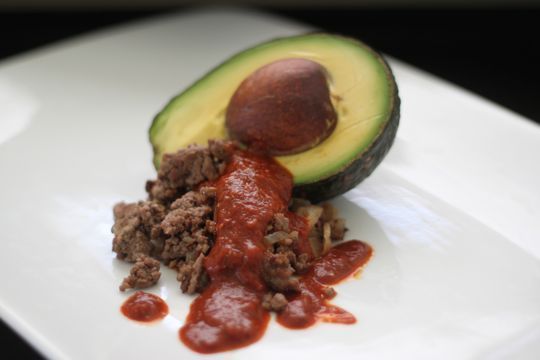 Call it what you will, chile (or chili) gravy or enchilada sauce, either way this blend of dried chiles, cumin, garlic, and beef broth is hard to be without if you love Tex-Mex cuisine. Granted, a lot of Tex-Mex cuisine is also loaded with gooey melted cheese, chips and tortillas but it’s best to skip all that. Instead, pour this earthy, smoky, moderately spicy gravy over ground beef, scrambled eggs, chilaquiles, grilled steak or chicken. Or use it (un-thickened) as a braising or poaching liquid for beef, pork or chicken.
Call it what you will, chile (or chili) gravy or enchilada sauce, either way this blend of dried chiles, cumin, garlic, and beef broth is hard to be without if you love Tex-Mex cuisine. Granted, a lot of Tex-Mex cuisine is also loaded with gooey melted cheese, chips and tortillas but it’s best to skip all that. Instead, pour this earthy, smoky, moderately spicy gravy over ground beef, scrambled eggs, chilaquiles, grilled steak or chicken. Or use it (un-thickened) as a braising or poaching liquid for beef, pork or chicken.
Every Tex-Mex aficionado has their own recipe for chili gravy. Some recipes use only chili powder, instead of whole, dried chiles, which works well if you have access to high-quality, flavorful chili powder. Many recipes use powdered garlic instead of fresh. And all of them use flour to thicken the gravy. This Primal version relies on tapioca powder to thicken the gravy, but even that’s not entirely necessary if you’re okay with a slightly thinner texture.
Besides great Tex-Mex flavor, what other reasons are there to spice up your food with chili gravy? Both fresh and dried peppers contain important nutrients, including antioxidants, and have potential cardiovascular and anti-inflammatory benefits.
Servings: 1 to 2 cups of chile gravy
Time in the Kitchen: 45 minutes
Ingredients:
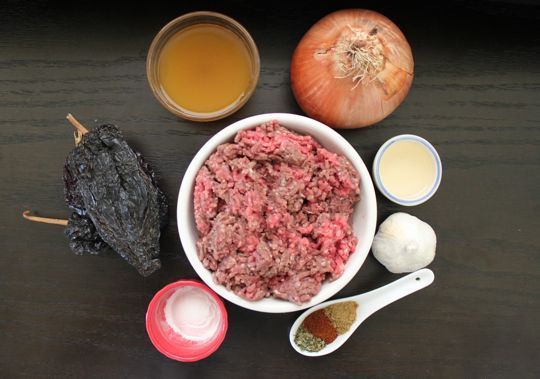
3 dried ancho chiles, seeds and stems removed
3 tablespoons lard (or if you must, cold-pressed high-oleic/high-stearic sunflower oil)
1/2 a yellow onion, finely chopped
4 garlic cloves, chopped
2 teaspoons ground cumin (10 ml)
2 teaspoons chili powder (10 ml)
1/2 teaspoon dried oregano (2.5 ml)
2 1/2 cups beef broth (600 ml)
1 tablespoon tapioca flour (15 ml)
Instructions:
In a dry skillet or pot heated on high, toast the chiles on each side for about 10 seconds. Cover the chiles with water, bring the water a boil and then turn off the heat. Let the chiles soak for 30 minutes to re-hydrate. Drain the chiles (discard the water). Put the chiles in a blender and set aside.
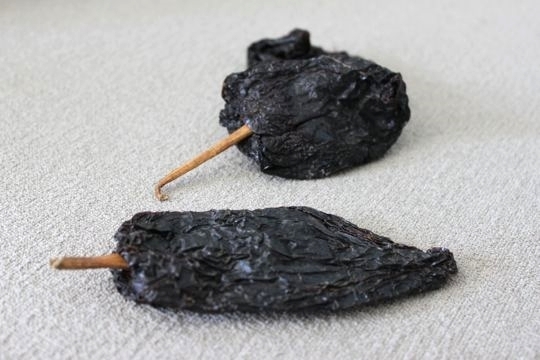
Warm the lard in a skillet over medium heat and add the onion, cooking for about 10 minutes until totally soft. Add the garlic and sauté for a minute or less to soften. Scrape the lard, onion and garlic into the blender with the chiles along with the cumin, chile powder, oregano and broth. Blend until very smooth.
Return the sauce to the stove and gently simmer for 10 minutes. Season well with salt.
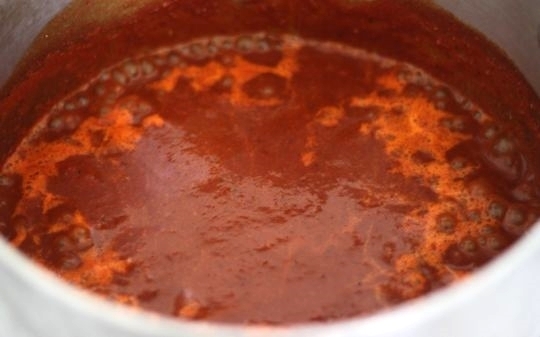
Just before serving, whisk the tapioca flour with 1 tablespoon (15 ml) of water then slowly whisk the liquid into the sauce.
To serve over ground beef, cook a pound of ground beef in a skillet with chopped onion, garlic and cumin. Pour the chili gravy on top before serving.
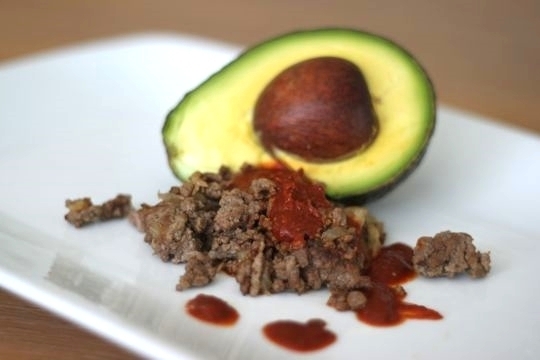
Not Sure What to Eat? Get the Primal Blueprint Meal Plan for Shopping Lists and Recipes Delivered Directly to Your Inbox Each Week




May 9, 2014
Food Is My Medicine
It’s Friday, everyone! And that means another Primal Blueprint Real Life Story from a Mark’s Daily Apple reader. If you have your own success story and would like to share it with me and the Mark’s Daily Apple community please contact me here. I’ll continue to publish these each Friday as long as they keep coming in. Thank you for reading!
 I was always very slim as a child. This was probably partly good genes and partly my parents making sure my sister and I ate plenty of veggies and meat (grass-fed from their hobby farm), plus playing sports, riding my bike and exploring my parent’s hobby farm, as well as my mother strictly controlling our portion sizes when at home. We had homemade cakes/biscuits for snacks, and often had dessert after dinner. When I went for my interview at the local teaching hospital to do my nursing training after high school, I was told to put on some weight. I am 5’ 7” and was 54 kg (119 lbs) at the time, so over the next three months I ate lots of white potatoes and butter, and managed to put on 3 kg (6.6 lbs), so I got to 57 kg (125 lbs). This was a nice, healthy-looking weight for me.
I was always very slim as a child. This was probably partly good genes and partly my parents making sure my sister and I ate plenty of veggies and meat (grass-fed from their hobby farm), plus playing sports, riding my bike and exploring my parent’s hobby farm, as well as my mother strictly controlling our portion sizes when at home. We had homemade cakes/biscuits for snacks, and often had dessert after dinner. When I went for my interview at the local teaching hospital to do my nursing training after high school, I was told to put on some weight. I am 5’ 7” and was 54 kg (119 lbs) at the time, so over the next three months I ate lots of white potatoes and butter, and managed to put on 3 kg (6.6 lbs), so I got to 57 kg (125 lbs). This was a nice, healthy-looking weight for me.
I got married at 20, had two children by 25, and despite putting on a bit of weight during my second pregnancy, I was back to 58 kg (128 lbs) within a short time and stayed there for about the next seven to eight years. In this time I did some aerobics classes and walking, as well as working part-time as a nurse.
During high school I had started eating chocolate (any kind, often with coloured/flavoured fillings) on a reasonably regular basis, and once I moved from part-time to full-time work this became an extremely regular thing, as I had more money. Everyone “knew” that if they were looking for a gift for me, a box of chocolates was always well-received. I never put on any weight or had problems such as acne, so I figured the chocolate and sugar weren’t doing me any harm! (If only I had known.)
Over this time I got fairly regular bladder infections, which required antibiotics, and more and more frequently I succumbed to thrush infections as a result (my poor gut microbiome!). After a number of years, I seemed to get thrush infections regularly without even taking antibiotics. I got a cold about once a year.
Around my early 30s, I suddenly noticed that I now weighed 64 kg (141 lbs). I decided that I liked this new more voluptuous me, and my friends agreed that women looked better with a bit of extra fat as they got older. I also noticed changes in my bowel habits, but was reassured by my doctor that my symptoms could be fixed by drinking more water and ensuring a good fibre intake. I also noticed that my waist was gradually increasing in size, so that I had to alter the size and type of clothes that I purchased and wore. I started to think that maybe I had ovarian cancer, but a blood test (ca125) said this wasn’t the case. A pelvic ultrasound was normal.
Over the years my gut symptoms became more and more of a problem. My tolerance for fat plummeted, I started suffering from indigestion and nausea, and I began to suffer from chronic constipation. I saw several gastroenterologists, had tubes poked everywhere, was told that I had a bit of “redness” in my stomach, and maybe I had “Irritable Bowel Syndrome.” All these doctors just gave me the laxative/water/fibre advice like everyone else. I also had an abdominal scan which showed “multiple cysts” in my liver. My constipation got so bad that without laxatives, I could go a week between bowel movements and it was seriously hard work. So hard in fact that in mid-2010 I had to have an umbilical hernia repaired, which was a result of straining so much. By this time my belly was also so distended that I was buying “loose fit” tops to try and hide what looked like a five month pregnancy.
 As my gut symptoms were increasing, I also noticed that sometimes when walking I seemed to start to lose my balance. At first this was infrequent, but over time, it happened more often. I also became so tired that I had to have a sleep most afternoons and always felt exhausted after dinner. I got colds several times per year. I suffered from depression as well and took anti-depressants for a total of five years. I gradually got more and more varicose veins, as well as many spider veins around my ankles and the sides of my feet.
As my gut symptoms were increasing, I also noticed that sometimes when walking I seemed to start to lose my balance. At first this was infrequent, but over time, it happened more often. I also became so tired that I had to have a sleep most afternoons and always felt exhausted after dinner. I got colds several times per year. I suffered from depression as well and took anti-depressants for a total of five years. I gradually got more and more varicose veins, as well as many spider veins around my ankles and the sides of my feet.
My menstrual periods also gradually got heavier and heavier, sometimes necessitating several changes of clothing each day as my pads and tampons could not cope with the flow of both liquid blood and large clots. I had to stop donating blood because I kept getting anaemic, and suffered nausea and dizziness after donating. I eventually got an IUD inserted with slow-release progesterone embedded in it, which after three months in situ, stopped my periods.
I often suffered from mouth ulcers and cracking at the corners of my mouth. The mouth ulcers I treated with a topical preparation, and I eventually discovered that taking vitamin B tablets regularly helped with the mouth cracking and frequency of ulcers.
I had been on a very high-sugar diet up this time too…not just my beloved chocolate (now dark usually, but with fillings), but also lots of meat/veggie stir-frys with sugary Asian sauces, sandwiches with honey or jam, and toasted (read sugary) muesli for breakfast. I was also strictly eating margarine and vegetable oils as my “healthy fats.”
In mid-2010 I had to have a BCC skin cancer cut off my face, near my eye, as well as have a “spot” treated with dry ice.
In September 2010 I went to see two different naturopaths about my gut symptoms, as conventional medicine seemed to have failed me. One of them helped me start to turn my life around. He looked at my live blood under a microscope, and my blood was in bad shape. Firstly, it was full of yeast. He recommended a one-month “low-yeast diet.” After some research on the internet, I decided to give it a go – it was very difficult, and after a few days I had a yeast “die-off” in the middle of the night, which included chills and massive shivering for about 20 minutes. I had signs of anaemia, my white blood cells were out of balance, and I had signs of calcium deficiency, metal toxicity, and vitamin deficiencies, and general gut ill-health. An oral “zinc taste test” showed a high level of zinc deficiency.
The low yeast diet was effective in decreasing my blood yeast levels, as shown when the naturopath looked at my blood a month later, and my waist size decreased by about 3 cm (1.2 inches), but the bloating and constipation were still a huge issue.
In late November 2010 my life changed. One day I noticed that I had what seemed to be a vaginal prolapse. A visit to the doctor led to an ultrasound, which showed a fist-sized lump on my left ovary. On the 10th of December I had a large Teratoma (encapsulated mixed-cell tumour- with some borderline cells) removed via a total hysterectomy and omentectomy. The next day I had an internal hemorrhage requiring a transfusion of three units of blood. I went home after eight days in hospital but was readmitted three days later with a severe pelvic infection requiring triple intravenous antibiotics for several days.
This surgery meant instant menopause at age 44. I did not want to go on artificial HRT, but after two months, my body felt like it was drying up, I had dreadful insomnia, and my brain was mush. After some investigation, I started on daily Bio-identical hormones, which helped me feel almost normal.
My naturopath had told me that after the month on a low-yeast diet, I could eat on an 80/20 rule, being 80% sugar free, 20% not. My gut symptoms, although somewhat diminished, were still a big problem, as were the weird head feelings. I ate this way until mid-March 2012, by which time I realised that I was eating more like 50% sugar free, 50% not.
One day, my husband heard a lawyer named David Gillespie talking on the radio about a new book he had written, called Big Fat Lies, about sugar/industrial seed oils and his weight loss journey. I listened to the podcast of the interview, bought his book, as well as his previous one, Sweet Poison, realised how bad my diet (SAD – Standard Australian Diet from the Australian Food Pyramid) was, and decided to quit sugar and seed oils. Initially this meant no chocolate, no desserts, porridge without sugar, no sugar in my coffee, and olive oil instead of vegetable oils. Over the next few months I did lots of reading and research, as did my son and also my father. Around the same time they both discovered MarksDailyApple.com.
My naturopath had been suggesting for a long time that I try giving up gluten, but it wasn’t until I looked at Mark’s website, and then purchased and read The Primal Blueprint and Nora’s Primal Body, Primal Mind, that I decided to stop eating gluten. Within three days I had lost 5 cm (2 inches) of bloating off my waist!! I then decided to give up my beloved oats for breakfast – more bloating gone!!
In September 2012 I decided to look at every label on every product in my pantry and fridge. I removed anything with added sugar and grains, dried fruit and honey, and seed oils…about 2/3 of things were gone. I then restocked with coconut products and other “Paleo/Primal” goodies. I subscribed to Mark’s newsletter, and when my aerobics membership ran out in December 2012, I started working through the Primal Blueprint Fitness plan, starting with the very basics. I walk the dog most days, go bushwalking once a week, do resistance exercise twice a week and sprint once a week (using a rowing machine as my left ankle/knee doesn’t like running).
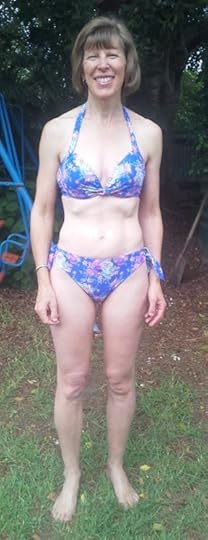 At 47, I am now back to 57 kg (125 lbs). I don’t eat any sugar, including honey, maple syrup, dextrose or rice malt syrup, or stevia. My waist is now 14 cm (6 ½”) less than before changing my diet, my skin is glowing, and I have had just one three day cold in one and a half years. My gut is very happy, as long as I take a probiotic capsule every day, and I tolerate lots of good fats. The spider veins around my ankles and feet are slowly receding. My vitamin and mineral levels are good, except when I tried eating white rice for about a month last year, which caused me to almost lose my taste from zinc deficiency. I have lots of energy most days, and rarely rest during the day. My head is also happy; no more dizzy feelings. My lipid studies, vitamin D, C-reactive protein, fasting insulin and HbA1c are great. I no longer get mouth ulcers or cracks at the corners of my mouth.
At 47, I am now back to 57 kg (125 lbs). I don’t eat any sugar, including honey, maple syrup, dextrose or rice malt syrup, or stevia. My waist is now 14 cm (6 ½”) less than before changing my diet, my skin is glowing, and I have had just one three day cold in one and a half years. My gut is very happy, as long as I take a probiotic capsule every day, and I tolerate lots of good fats. The spider veins around my ankles and feet are slowly receding. My vitamin and mineral levels are good, except when I tried eating white rice for about a month last year, which caused me to almost lose my taste from zinc deficiency. I have lots of energy most days, and rarely rest during the day. My head is also happy; no more dizzy feelings. My lipid studies, vitamin D, C-reactive protein, fasting insulin and HbA1c are great. I no longer get mouth ulcers or cracks at the corners of my mouth.
My adult children also follow a fairly strict Primal way of eating. My daughter has eczema and has recently been diagnosed with kerataconus, both of which are inflammatory conditions, so she is trying a month of strict Paleo without dairy at the moment to see what happens. My husband has been a fervent embracer of giving up sugar and seed oils, but has struggled to give up beer and pizza when out with his friends. However, over the past year he has noticed many health improvements from being 80% Primal: gums no longer bleed when he brushes his teeth, aches and pains at night are gone, softer and more glowing skin, gastric reflux gone. He has lost a little bit of weight and wants to lose more, but can’t seem to. His high sensitivity C-reactive protein is elevated (37 last month) so he still has quite a bit of inflammation. A week ago he started a Whole 30, which for him meant cutting out milk and cheese (his go-to snack) and alcohol. So far, the pimples on his neck, which he always seems to have, are gone, he is losing weight and his mood and energy levels are more even. His sleep is also somewhat better – he is a terrible sleeper and falls asleep at the drop of a hat. The next three weeks should be very interesting…
The only thorn in my side is the fact that ever since I went Primal, my hormone levels have been erratic, causing my hormone doctor to have to regularly adjust my prescription, and I constantly have dry skin and eyes (not good with contact lenses). Having a month of eating white potatoes and rice didn’t seem to help. At the moment I am waking up most nights with a mild hot flush, so I am a bit tired during the day. My oestrogen (71pmol/l) and testosterone (<0.24 nmol/l) levels are low and SHBG (133 nmol/l) is up, but my doctor can’t work out how to best fix the situation. My progesterone is slightly high at 23 nmol/l. I am still on bio-identical hormones.
I have done huge amounts of reading and research over the past couple of years, but I make sure that MarksDailyApple.com is my breakfast reading. I am also enjoying the new Primal Blueprint podcasts. As well as trying to follow the 10 Primal Laws, I have recently given up shampoo/conditioner in favour of bicarb soda and apple cider vinegar. I despair when I look around me at all the sick people walking down the street, but cheer to myself every time the media releases another story about the dangers of sugar, seed oils or processed foods. Food is my medicine.
Debbie
Like This Blog Post? Dig Deeper with Primal Blueprint Books and Learn How You Can Reprogram Your Genes to Become Leaner, Stronger and Healthier




May 8, 2014
How to Overcome the “I’ll Do It Tomorrow” Instinct
 It’s a long and irrelevant story as to how this movie reference re-entered my consciousness lately, but bear with me. I’m not into Rom-Coms (surprise, surprise), but let’s just say I have people in my life who are. There’s a famous scene in the old 80s flick When Harry Met Sally (no, not that one…) when Billy Crystal runs a couple miles through Manhattan fueled by the realization that “When you realize you want to spend the rest of your life with somebody, you want the rest of your life to start as soon as possible.” Don’t give me too many points for this (thanks, Google), but that line has stuck with me since I heard it who knows how many years/decades ago. Yes, it’s a nice sentiment, but at the time I admittedly connected (again, little surprise) more of a trainer’s message to it. (Shameless, I know.) When you know the life you want, why wouldn’t you want to begin it now? Why would you put off what you want today for tomorrow? No, Rome wasn’t built in a day, but there’s a lot to be said for the feeling of being on the path. Mentally and physically, you reap the benefit of every day you live a better life, no?
It’s a long and irrelevant story as to how this movie reference re-entered my consciousness lately, but bear with me. I’m not into Rom-Coms (surprise, surprise), but let’s just say I have people in my life who are. There’s a famous scene in the old 80s flick When Harry Met Sally (no, not that one…) when Billy Crystal runs a couple miles through Manhattan fueled by the realization that “When you realize you want to spend the rest of your life with somebody, you want the rest of your life to start as soon as possible.” Don’t give me too many points for this (thanks, Google), but that line has stuck with me since I heard it who knows how many years/decades ago. Yes, it’s a nice sentiment, but at the time I admittedly connected (again, little surprise) more of a trainer’s message to it. (Shameless, I know.) When you know the life you want, why wouldn’t you want to begin it now? Why would you put off what you want today for tomorrow? No, Rome wasn’t built in a day, but there’s a lot to be said for the feeling of being on the path. Mentally and physically, you reap the benefit of every day you live a better life, no?
Yet, damned if we don’t play that old, sabotaging card – putting off our goals for a mythical tomorrow. What is it with us humans? For some strange reason, we bring this magical thinking to time, imagining that tomorrow will somehow be fundamentally different than the same hour today. Yes, a different date will come up on your phone tomorrow morning, but that singular digit holds no particular capacity. Do we honestly think something will be changed tomorrow? We’ll win the lottery and not have to go to work? The kids will dress and feed themselves with no reminders or aid? Our brains will be more motivated and capable of accepting change? Our bodies will have gained strength and stamina overnight to crave a hard workout?
You could say it’s simply abject laziness. You could call it inertia. I’d suggest you’d be right to a degree in both cases. Add to this, I think, the acknowledgment that the human mind is immensely gifted in the art of mental games. While we rationally know we earn our goals one exertion or test at a time, we see future investments as somehow more fruitful. I wonder why we accept that illusion so readily? The fact is, all days themselves are created equal. Yet, today is the one you have in front of you. It’s the one you have to work with. Tomorrow will actually be “today” in a few hours, and all that magical thinking you imbued it with will vanish. It will – gasp! – feel just like today except you’ll have lost the benefit of the day before. And we will once again be surprised.
Whether it’s a modern or simply human tendency perhaps doesn’t matter. The real question is this: how do we push back on our tendency to put off what could be started (and enjoyed) today?
Lose the cold turkey mentality.
Sure, it works for some people to make change in one big push. However, if a fixation on the cold turkey method keeps you from actually making meaningful change, accept that this particular approach isn’t going to work for you. If you can’t make a perfect choice, make a great choice. If you can’t make a great choice, make a good one. If you can’t make a good one, then at least avoid going nuclear (e.g. skip the drive thru).
Commit to something that will push your process forward.
Behavior change experts often cite the “cycle” of change theory, which holds that people go through a series of steps to institute a behavior change, including a beginning precontemplation stage (denial and justification), a contemplation stage (consideration and information gathering), preparation (planning and troubleshooting), action (implementing and substituting behaviors) and finally maintenance (continuing and refining action). If you can’t bring yourself to action today, do something to push forward your contemplation or (better yet) preparation. Make a list of healthier meals you could make for dinner, buy better food for any snacks you feel you must have in a day or come up with three ways to fit in some kind of physical activity after work. If you don’t do anything different today, you won’t be in a position to achieve anything different tomorrow.
Make a “present moment” commitment.
Overwhelmed by devoting a whole day to healthy behavior? Choose to make better (not perfect) decisions for an hour. If it needs to be 15 minutes, make it 15 minutes. That’s all. Walk past the vending machine. Don’t eat anything left over from the meeting that’s sitting in the break room. Get up 15 minutes early and make some eggs for breakfast. Do some bodyweight exercises for 15 minutes. Spend 15 minutes of your lunch hour walking and getting some sun.
Make it easier.
If you’re resistant to doing what’s healthy today, maybe it’s because you associate too much effort with a good choice. When we’re early in the behavior change game, a little extra effort can feel larger than it is. Keep healthy as simple as possible. Do as much as you can to make it difficult to fail. Set an alarm for yourself to go work out. Accept any workout as a small victory. Go out to a restaurant where you know you can simply order steak and salad. Go to bed an hour early. Go for low hanging fruit today if you’re tempted to wait until tomorrow.
Surrender the delusion that change is about the right circumstances.
It’s so easy to blame a long day at work, your kids, your spouse, budgetary constraints, daily stress, a bad night’s sleep, the weather, yada, yada, yada. (Who or what in the universe is your favorite scapegoat? Go on. We all get cranky some days.) Guess what? Life never gets easy. If you’re waiting for a magic, barrier-free stretch, good luck. People who experience the most success, satisfaction and peace in their lives are the ones who don’t wait around for it. Tomorrow will present its own set of annoying circumstances. Beginning will still be as inconvenient. Effortlessness is and will always be fiction. Accept reality and build your effort around it.
Get in a better mental place.
If the idea of committing to healthier behavior itself is too much, consider whether there’s a legitimate need behind your resistance. Are you tired? Hungry/”Hangry”? Overstimulated? Anxious? Lonely? Are you ready to eat that donut because it’s 2:00 and you’re realizing how much you hate your job or because it’s 8:00 at night and you resent being stuck at home alone? What do you need to do to get out the emotional trap? (Hint: Krispy Kreme or Ben and Jerry’s won’t help.) Do something fun. Yes, a brisk run or healthy salad would work your biology toward your emotional advantage, but do what you can. If it needs to be eating a hardboiled egg to drum up the energy to make something more substantial for lunch, do that. If it needs to be turning around a cynical, woe-is-me mind by watching 10 minutes of Louis C.K. on YouTube, do that. If you need to get 5 minutes of sun to wake up, there you go.
Contact somebody – anybody.
For the love, don’t think you have to do it alone. If you don’t have a friend or partner you can count on for encouragement, get involved in the forum here. Send a message today. Now would be good. (The comment board below can work, too.) Even a well-designed app can be a holding container or feedback source in a pinch. I highly recommend getting out of your own headspace as often as possible. Sometimes it’s your greatest asset. Other times it can be the most defeating place you’ve ever visited. When your best thinking is keeping you stuck in the illusion of “I’ll start tomorrow,” it’s high time you tapped into someone else’s perspective on what can be done today.
Have you ever found yourself on the inert side of “I’ll do it tomorrow?” What got you over the hump? Share your anecdotes and suggestions, and thanks for stopping by, everyone.
Not a Subscriber? You Are Missing Out. Subscribe for Free Today and Instantly Get 8 Primal eBooks and So Much More!




May 7, 2014
How to Establish a Healthy Gut in Your Primal Baby
 Yes, folks: it’s another post about the gut. But today’s advice is geared toward all the Primal babies out there in preconception, in utero, and in diapers. Because for the first few years, they’re pretty helpless and ignorant in matters of the gut. They need your help to establish and maintain a healthy intestinal environment. They need your expertise and guidance and occasional intervention. And sometimes, as you’ll see, they need you to give them the freedom to do some often unpleasant-looking activities that pay dividends to longterm gut health.
Yes, folks: it’s another post about the gut. But today’s advice is geared toward all the Primal babies out there in preconception, in utero, and in diapers. Because for the first few years, they’re pretty helpless and ignorant in matters of the gut. They need your help to establish and maintain a healthy intestinal environment. They need your expertise and guidance and occasional intervention. And sometimes, as you’ll see, they need you to give them the freedom to do some often unpleasant-looking activities that pay dividends to longterm gut health.
Since most of the immune system resides in the gut, and the development of a kid’s gut microbiome is in many ways the development of his immune system, this turns out to be a helpful guide for parents interested in optimizing their child’s immune system.
Prenatal Considerations
Avoid obesity. Maternal obesity during the prenatal period creates an inflammatory placental environment that can predispose the offspring to gut issues after birth, including leaky gut and intestinal inflammation. So don’t become obese. And if you are, it’d be ideal to become less so before getting pregnant. This is best done before you get pregnant, as dieting during a pregnancy can be hard on everyone involved and not generally recommended.
Avoid gluten. Studies in diabetic rodents show that a maternal gluten-free diet can improve the gut barrier function and reduce the incidence of diabetes in the offspring, even in non-celiacs.
Take probiotics and eat fermented food. Although researchers used to think that infant guts were completely sterile before birth and only became seeded during their journey through the birth canal, new research is upturning that old assumption and leading scientists now say that the “tenet that healthy fetuses are sterile is insane.” Bacteria is found in amniotic fluid, umbilical cord blood, and the placenta. Colonization of a fetus’ gut begins in the womb. Maternal probiotic usage directly affects the gut microbes of the fetus.
Do the “do’s” and don’t do the “don’t”s listed in yesterday’s post on leaky gut. The nutrients your body uses to support the gut barrier are likely the same ones your body uses to support your growing child’s gut barrier. The environmental triggers and stressors that support and impair gut health in your body are likely to have the same effect on the body growing in your womb.
Birth Considerations
If possible, have a vaginal birth. Microbial colonization may start in utero, but the most important exposure to bacteria occurs as the baby travels down the birth canal, through the vagina, and into the world. This only happens in natural vaginal birth.
Home birth might be optimal (but it’s not necessary). One study out of Holland found that kids who were born at home and exclusively breastfed had the most “beneficial” gut microbiome. If you’re comfortable with home birth and are due to have a low risk pregnancy, give it some consideration.
Avoid unnecessary c-sections. Do not avoid c-sections if they are medically necessary. But if you’re faced with the option of a c-section or a vaginal birth, consider that babies born to c-sections are more likely to have decreased microbial diversity, impaired immune responses to stimuli, and lower colonization by beneficial bacteria. Boys born via c-section are more likely to have Crohn’s disease and babies of both sexes born via c-section are more likely to develop celiac.
In the event of a c-section, give your baby probiotics. Studies show that breastfeeding after a c-section isn’t quite enough to make up the differences in gut flora, so an infant probiotic with the right strains can really come in handy. I also wonder if a vaginal swab from the mother applied to the baby’s mouth and body directly after a c-section would help properly inoculate the gut. Good luck getting your OB to agree to that one!
Postnatal Considerations
Breastfeed. This is the most important one. Breast milk contains probiotics that colonize your baby’s gut and prebiotics that feed the probiotics in your baby’s gut. Chances are, breast milk probably contains other compounds yet to be discovered that also have a beneficial effect on gut health. Be sure to eat a good diet, because the food and nutrients you eat will make it into your milk.
Try goat-based formula if you go that route. Formulas based on goat milk instead of cow milk (or soy) result in infant fecal bacteria most similar to fecal bacteria from breast-fed babies. That goat milk contains similar glycans as human milk could explain the similarity.
Look for formula with prebiotics. An important component of human breast milk are the human milk oligosaccharides (HMOs), prebiotics that feed, nurture, and promote the establishment of healthy gut flora in the baby. HMOs aren’t yet commercially available, but some prebiotics have been shown to come fairly close. One recent trial found that an inulin-fos blend (this one, to be exact) promoted “a gut microbiota closer to that of breastfeeding.” Is it as good as breast milk? No. Better than nothing, though.
Let them play outdoors. Outdoor play is pro-gut for several reasons. If there’s sun out, your kid will get plenty of vitamin D – an important nutrient for the integrity of the gut lining. If they’re outdoors, they’re probably getting exposure to dirt. Dirt is full of microbes (both “good” and “bad”) and the human gut (having evolved in an unsterile, natural environment, i.e. the outdoors) is primed for constant, low level exposure to these soil-based organisms. Playing outdoors, making mud pies, and sampling the culinary offerings of garden soil all help seed the gut. And finally, kids who are allowed outdoor free play are less stressed, less anxious, and happier than kids who are not. Increased stress levels can wreak havoc on the gut by inducing intestinal permeability (PDF) and affecting the stability of microbial populations.
Let them play with other kids – even (or especially) the “dirty ones.” Provided you’ve been following as many of the previously mentioned steps as you can, your kid will have a robust immune system and a healthy microbiome that can handle and even benefit from exposure to other child-borne microbes.
Don’t freak out if they eat their boogers. Eating boogers boosts immunity, and the health of the immune system is a window to the health of the gut. I don’t want parents to start home brewing booger smoothies drawn from healthy donor noses. That’s extreme (and disgusting). But if you see your kid pick his or her nose and eat it, don’t worry so much. It could be helping. Besides, they’ll do it anyway when you’re not looking.
Don’t demand antibiotics at the first hint of sickness. I’ve said it before and I’ll say it again: antibiotics have done us a lot of good, but they are extremely powerful tools that deserve respect rather than carelessness. New guidelines for childhood ear infections echo my concerns and actually urge caution when it comes to antibiotic prescriptions, citing research that shows most kids get over ear infections on their own within 2-3 days without antibiotics. And many childhood illnesses (like viral ones) don’t even respond to antibiotics, but parents still demand them anyway. Don’t be one of those parents.
Doing all these thing doesn’t guarantee good gut health for your baby, but based on the current levels of evidence available, it’s probably your best shot.
What did I miss? Got any other tips for parents interested in optimizing their baby’s gut health?
Thanks for reading.
Get the 7-Day Course on the Primal Blueprint Fundamentals for Lifelong Health Delivered to Your Inbox for FREE




May 6, 2014
A Primal Primer: Leaky Gut
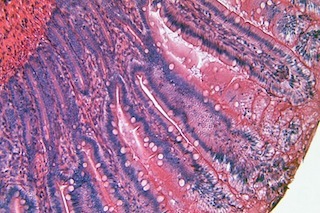 After I mentioned it in last week’s 10 Principles of Primal Living (Finally) Getting Mainstream Media Coverage post, several readers emailed asking about leaky gut. What is it? How do I know if I have it? Why should I care if I have it? What do I do if I have it? And so on. Turns out many and maybe most people have but a vague idea of what leaky gut actually means.
After I mentioned it in last week’s 10 Principles of Primal Living (Finally) Getting Mainstream Media Coverage post, several readers emailed asking about leaky gut. What is it? How do I know if I have it? Why should I care if I have it? What do I do if I have it? And so on. Turns out many and maybe most people have but a vague idea of what leaky gut actually means.
Today, I’m going to fix that.
In most popular conceptions of human physiology, the gut exists primarily as a passive conduit along which food travels and breaks down for digestion and absorption. It’s where bacteria hang out and digestive enzymes go to work. It’s a “place,” an inert tunnel made of flesh and mucus. Lots of things happen there but the gut itself isn’t doing much.
Except that the gut serves another very important and active role: as a dynamic, selective barrier between us and the external world with all its nasties. Dynamic in that it responds differently depending on what’s trying to get through. Selective in that it’s supposed to let in good things and keep out harmful things.
Lining the gut are cells called tight junctions. These are our doormen. These are the dynamic, selective parts of the gut. Like the doorman, the tight junction’s job is to discern between what belongs inside and what doesn’t. What gets passage through the gut lining into our body and what is denied. Tight junctions keep out pathogens, antigens, and toxins while admitting nutrients and water.
That’s in a perfect world, though. Sometimes the doorman shows up to work drunk. Sometimes the doorman can’t turn down the $100 bill enfolded in a handshake. Sometimes the doorman lets the pretty girl and all her friends cut in line. Many variables can affect the doorman’s ability to discern between who belongs and who doesn’t. And the same goes for intestinal tight junctions.
How do you know if you have leaky gut?
Everyone’s gut is a little leaky, a little permissive if not downright permeable.
One way is to take an intestinal permeability test. You drink a solution containing a pre-measured amount of mannitol and lactulose, two indigestible sugars. You collect your urine over the next 6 hours and measure the amount of excreted mannitol and lactulose to determine how much permeated through your gut.
Another way is to measure levels of blood zonulin, a reliable marker of intestinal permeability. You might have trouble convincing your doctor to order this one.
You can also look at the list of conditions commonly associated with elevated intestinal permeability. If you have any or all of them, you may have leaky gut. Put another way, if you have leaky gut, you may be at a greater risk for some of these. What are they?
Celiac disease: When gluten is broken up into fragments in the gut, those fragments induce the release of zonulin, which tells the tight junctions to become more permeable. This happens to everyone whose guts come into contact with those gluten fragments, but the effect is enhanced in people with celiac. Their gluten-induced leaky gut is way more leaky than it should be, and it stays leaky long after the gluten has been gone. In fact, a common test for celiac is the very same intestinal permeability assessment I just mentioned.
Inflammatory bowel disease (IBD): Patients with Crohn’s disease, an inflammatory bowel disease characterized by severe inflammation of the gut lining, tend to have leaky gut. And in general IBD, which includes Crohn’s and ulcerative colitis, high intestinal permeability precedes the development of the disease.
Irritable bowel syndrome (IBS): As discussed yesterday, IBS patients often show increased gut permeability. Some researchers suggest that leaky gut leads to the kind of chronic, low-level inflammation that characterizes IBS.
Asthma: There is a high prevalence of leaky gut in people with moderate to severe asthma, though researchers aren’t sure whether it’s a cause or consequence of the asthma.
Food allergies and intolerances: The transportation of the food allergen across the gut lining appears to be a necessary step in the development of a food allergy, and a 2011 review concluded that an overly leaky gut facilitates this transportation and leads to the inducement of allergy.
Autism: Children with autism and their first-degree relatives tend to have abnormal gut permeability, suggesting a gene-environment component to autism. This is present in some, but not all people with autism.
Rheumatoid arthritis, ankylosing spondylitis, and other autoimmune diseases: Both RA and AS have been linked to leaky gut, and the connection may hold for other autoimmune diseases, too.
Obesity and metabolic syndrome: Both obesity and metabolic syndrome are often linked with intestinal permeability, and a recent paper explores all the potential mechanisms that might explain the link.
Depression: By some accounts, 35% of depressed patients have leaky gut.
Eczema: Going back as far as 1986, researchers have found leaky gut to be common in eczema patients.
Interesting, huh? Leaky gut really gets around. It may not be the whole story, and some of these connections may be coincidental, but plausible mechanisms exist for most of them and I’m confident that fixing leaky gut will improve many seemingly disparate health problems.
Plus, even if it wasn’t the proximate cause of your health problems, leaky gut probably isn’t helping you get better and you should try to fix it. Multiple feedback loops which make teasing apart cause and effect nearly impossible also make it possible to step in the middle of the loop(s) and break it up.
Leaky gut: what it is, how to know if you have it, and what to do about it: http://ctt.ec/5f8B4+

What should you do?
First, avoid things that might cause it.
Gluten. Gluten begets gliadin releases zonulin induces leaky gut. I discussed this in the celiac section above, but it’s important to reiterate that gliadin has this leaky effect on every gut, not just in celiacs. Celiacs just get it worse than non-celiacs.
Stress. Stress can directly induce leaky gut (PDF) and stress can take many forms, as we all know. Bad finances, marital strife, unemployment, too much exercise, lack of sleep, extended combat training, and chronic under-eating all qualify as significant stressors with the potential to cause leaky gut, especially chronically and in concert.
Too much alcohol. Ethanol increases intestinal permeability by changing the gene expression of the proteins involved in tight junction function. If you do drink, be sure to follow best practices and definitely do not drink on an empty stomach. Alcohol also depletes zinc, which is a crucial pro-gut nutrient.
Poor sleep habits. In one recent study, mice whose circadian rhythms were disrupted were more susceptible to liver damage and alcohol-induced intestinal permeability.
NSAIDs. Non-steroidal anti-inflammatory drugs like aspirin and ibuprofen can be helpful in certain situations, but they are far from benign. One of their worst and most pronounced effects is leaky gut.
Then, take proactive steps to improve gut barrier function.
Take whey protein isolate and glutamine. Both supplements have been shown to reduce leaky gut in patients with Crohn’s disease.
Try resistant starch and other prebiotics. Whether potato starch, green bananas/plantains, mung bean starch, inulin powder, jersualem artichokes, leeks, pectin, or apples, start eating RS and other prebiotics on a regular basis. They increase butyrate production (which reduces intestinal permeability) and support the growth and maintenance of healthy microbial populations.
Take probiotics and/or (preferably “and”) eat fermented food. Prebiotics are important, but you also need to provide the right gut bugs if you’re deficient. You can do it with both supplements and food. L. rhamnosus and L. reuteri supplements reduce leaky gut and improve symptoms in kids with atopic dermatitis. L. rhamnosus also helps restore the gut barrier in kids with acute gastroenteritis. In rats with leaky gut, yogurt improves gut barrier function.
Get adequate sunlight and/or take vitamin D3 supplements. Vitamin D helps protect against injuries to the intestinal lining, while a vitamin D deficiency promotes intestinal permeability and inflammation.
Get enough zinc. Oysters, red meat, supplements – zinc supplementation reduces leaky gut.
Make broth, eat gelatinous cuts of meat. I don’t have any scientific references for this one, but it’s such a staple piece of advice in the “healing your gut” scene that it’s worth including. Plus, oxtails are magic, and science can’t quite explain magic just yet.
Exercise intelligently. Intense, protracted exercise induces leaky gut. This is normally transient and totally manageable, but if taken to the extreme as in chronic cardio, exercise-induced leaky gut can become a chronic condition. The same goes for any kind of chronic exercise. Even too much strength training can probably do it, though you’d have to do a ton of volume without much rest. Meanwhile, moderate exercise improves gut barrier function. The tried and true triumvirate of lifting heavy things, walking lots, and sprinting occasionally is the safest bet.
Check out a free Solving Leaky Gut webinar this Thursday. If you want to hear direct from the experts who’ve helped patients solve and cure leaky gut and many of the aforementioned health issues related to it, you’ll want to attend the webinar this Thursday, May 8 at 9 PM Eastern. It’s part of a larger package called Solving Leaky Gut that gets way deeper into the condition and offers specific, proven tips, tricks, and strategies for improving your gut function, reducing food intolerances, and boosting immune health.
If all this stuff seems daunting and far-reaching, that’s because it is daunting and far-reaching. The gut affects nearly everything. But look at the bright side: fixing your gut may be the key to good health for many of you. It’s actually quite empowering. Don’t you think?
Thanks for reading, everyone!
Not a Subscriber? You Are Missing Out. Subscribe for Free Today and Instantly Get 8 Primal eBooks and So Much More!




Don’t Miss the First-Ever East Coast PrimalCon, June 5-8!
 Greetings friends, it’s been a busy Spring for me with PrimalCon Vacation Tulum, Mexico in March and Paleo f(x) in April in Austin, TX. Next on the horizon is a trip back east for the BEA book publishing convention in New York City on Memorial Day weekend, followed by PrimalCon New York on June 5th-8th. I’m going to take a little time with the family between events to cruise out to my old stomping grounds on the coast of Maine. I really hope you can join me at the Mohonk Mountain House in New Paltz, NY, for this is going to be an amazing first-time event.
Greetings friends, it’s been a busy Spring for me with PrimalCon Vacation Tulum, Mexico in March and Paleo f(x) in April in Austin, TX. Next on the horizon is a trip back east for the BEA book publishing convention in New York City on Memorial Day weekend, followed by PrimalCon New York on June 5th-8th. I’m going to take a little time with the family between events to cruise out to my old stomping grounds on the coast of Maine. I really hope you can join me at the Mohonk Mountain House in New Paltz, NY, for this is going to be an amazing first-time event.
I’ve been finalizing the details with the resort, including our custom dining with all-Primal menus. The chefs at this historic resort are world-renowned, and they are eager to please our highly discriminating group. We’ll have a custom omelet bar in the mornings, a 52-foot long colorful buffet lunch, and some amazing four-course dinners served in their fabulous Victorian dining halls. How do these grab you at a glance? Pan-seared Filet Mignon tournedos, blue crab succotash, and lemon peppercorn butter; Grilled ahi tuna with papaya kiwi salsa; Apple-smoked duck breast with field greens and figs; Gorgonzola-crusted lamb rack with mango relish and cabernet pan sauce – and you know I could go on and on! As usual, we’ll be busting out the red wine and dark chocolate in front of a huge lakefront campfire in the evenings.
We always try to create fun outdoor adventures at PrimalCon, and Mohonk is cooking up some special adventures with their full-time recreation staff. We are going to tackle the famous labyrinth/lemon squeeze rock scramble (check some photos here). We’ll form several teams and participate in a special adventure race/scavenger hunt team challenge that will have you strategizing to knock off a bunch of wild and wacky To Do List items before your rival teams! If you’re a golfer, you must try the incredible sport of Speed Golf. Yep, you grab just a few clubs and race through the course as fast as you can, while still trying to score well (minutes and strokes each count for a point!). Of course, we’ll include my two favorite pastimes of Ultimate Frisbee on the Mohonk athletic field and Standup paddling on Lake Mohonk.
If you like an even deeper nature experience, we’re going to grab some shuttles and do a scenic hike into the surrounding state park to reach an amazing waterfall where you can cliff jump (this was definitely a highlight of PrimalCon Lake Tahoe and fast becoming a PrimalCon tradition!). Here is a mellow video of the beautiful surroundings of the hike, and this is a quick shot of some dude getting big air off the cliff jump! See, whatever your temperament, whatever your fitness level, whatever your background, PrimalCon is a rewarding, unforgettable experience for everyone.
Besides experiencing the natural surroundings and dining in style, we’ll have our usual full slate of amazing and diverse presenters. You can start your day the right way with the amazing Angelo dela Cruz, play with Darryl Edwards, get fit with Matt Whitmore and Keris Marsden, talk shop with Dr. Cate Shanahan, meet the guy who made paleo eating (and barefooting) cool in New York City, John Durant, and learn how to journal effectively for goal setting and motivation with Luke Shananan. If you have a less-informed significant other who’s thinking of tagging along, Mike DiLandro will deliver the Primal Transformation Seminar that effectively introduces new people to the movement.
We also have a new face in Dr. Mike Greenberg, a holistic healer who practices NEAT – Neuro-Emotional Antisabotage Technique. Get some 1:1 time with him and he’ll help you break free from stored emotional traumas that hamper your present health and peak performance – as he’s done for Olympic gold medal track stars.
Oh, and if all this excitement is making your tired already, and you think you might need to break away and relax during your stay, keep in mind that we are staying at the #1 rated resort spa in the entire United States (Conde Nast magazine). FYI – a good portion of PrimalCon guests have taken to extending their stays for a couple few days on either side of the formal agenda, just to keep the pace of their journey comfortable and decompress after such an amazing weekend experience.
I realize that getting up and out of your daily routine to break free for a weekend (and dent your budget in the process) is a big effort, but I promise you when you take the plunge and show up, you will be whisked promptly into an unforgettable experience. Yes, I’ve listed the many adventures and accouterments offered at the event, but perhaps the most fulfilling aspect of PrimalCon is the sense of connection and community you experience when you gather with like-minded folks across the globe. Well, I hope to see you at either Mohonk on June 5th-8th or Oxnard on Sept 25-28th. After all, 2014 only happens once so you might as well make it an amazing year with a PrimalCon experience!
If you have any questions about PrimalCon, please call (888-774-6259), email, or even try our new live chat (found at the bottom right of any page on PrimalBlueprint.com) so our staff can give you more details and assurance that this event will be just what you need to reinvigorate your interest in living a healthy, fit, primal lifestyle.
Join Mark Sisson and Friends at PrimalCon New York, June 5-8!>>




May 5, 2014
Dear Mark: IBS and Gluten, Tweaking Calories for Fat Loss
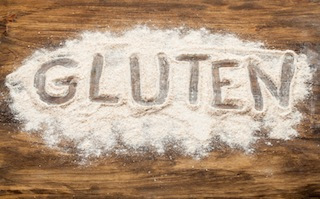 For today’s edition of Dear Mark, we’ve got a short but sweet two-parter. First up is the connection between Irritable Bowel Syndrome, gluten, coffee, and alcohol. A reader with a history of IBS triggered by gluten, coffee, and alcohol wonders if giving up gluten really could have solved his intolerances of the other foods. Then, I give my take on the best dietary strategy for losing the last few pounds of body fat for an otherwise lean individual. Believe it or not, I even mention and recommend counting calories.
For today’s edition of Dear Mark, we’ve got a short but sweet two-parter. First up is the connection between Irritable Bowel Syndrome, gluten, coffee, and alcohol. A reader with a history of IBS triggered by gluten, coffee, and alcohol wonders if giving up gluten really could have solved his intolerances of the other foods. Then, I give my take on the best dietary strategy for losing the last few pounds of body fat for an otherwise lean individual. Believe it or not, I even mention and recommend counting calories.
Yep. Let’s go:
Mark,
Hi. I have been a long time sufferer of IBS. I always thought dairy, liquor, and coffee were the main instigators of my problems. I just stayed away from all 3, and was only ever semi-fixed.
Recently (few months), and for unrelated reasons I went mostly primal. I definitely gave up refined sugar and flour. I noticed that my IBS symptoms have lessened a considerable degree! Out of curiosity I started drinking some liquor (after all I quit drinking beer) and haven’t noticed any ill effects. I even have had a cup or two of coffee here and there and have been okay.
Is it plausible the whole time gluten was my the main instigator? And if so, why were liquor, dairy, and coffee so involved? I used to not be able to finish a cup of coffee without running to the bathroom – but now if it was really gluten all this time — why did it have such an immediate effect…. how does the combination of these things affect IBS?
Basically, I’m writing you because I don’t trust my own observations? They seem so weird to me, and it seems too good to be true that I can enjoy a nice cup of coffee nowadays…. So am I lying to myself, or is there any known truth to my observations?
Thanks!
Brian
These are very good observations, not the deluded visions of a madman. It’s not just plausible that gluten was the main instigator. It’s probable. Check it out:
There’s an increased prevalence of celiac disease among children with IBS. Kids with IBS are four times more likely to have celiac.
Gluten-free diets improve both subjective and objective symptoms in IBS patients. A recent controlled trial in people with IBS-D (IBS with diarrhea) found that gluten-free diets improved bowel function, reduced bowel movement frequency, and lowered small intestinal permeability.
We should also note that it may not just be the gluten that’s problematic but the wheat itself, which contains dozens of other bioactive compounds that may be contributing to the problem. Eliminating gluten tends to also eliminate wheat, so it may be a moot point.
What about the relation of the foods you mentioned – alcohol and coffee – to gluten and IBS?
In large amounts taken in a short period of time (binge drinking), alcohol can increase IBS symptoms. But moderate and light drinking appear to have no relationship to IBS. If they reduce stress and improve enjoyment of life, they may even reduce the symptoms of IBS, for which stress can be a trigger. Gluten-containing beer may also exacerbate IBS, particularly if you’re gluten-sensitive or celiac.
How about coffee? It can increase intestinal motility, so if your IBS was of the diarrheal persuasion, coffee may have worsened symptoms. Some people also claim that coffee proteins and gluten share cross-reactivity – that the amino acid sequences in coffee and gluten are similar enough to provoke an autoimmune response from both. I haven’t seen any published research showing gluten-coffee cross-reactivity or a comparison of protein composition, just anecdotes, but that’s something to keep in mind.
What about leaky gut causing increased sensitivity to otherwise benign foods like coffee?
In IBS-D, you’ve got increased intestinal permeability across both the small intestine and the colon. IBS-C (constipation) patients have an interesting pattern of leaky gut: permeability is lower in the small intestine than controls and IBS-D patients. Many IBS patients oscillate between both constipation and diarrhea throughout the course of their symptomology, and gluten is a well-known inducer of intestinal permeability via zonulin – even in the absence of celiac – so you likely experienced some leaky gut which could have made other foods problematic.
Removing gluten removes a potential aggravator of general food intolerances, many of which present with abdominal cramping, bloating, diarrhea/constipation, and other hallmarks of IBS. Food intolerances themselves have been linked to IBS for decades.
So no, it’s probably not too good to be true. Enjoy your coffee and alcohol (in moderation)!
Hey Mark,
I forget if you mentioned this in an article or podcast, but you brought up the fact of having to get very strict regarding calorie intake if you want to drop into the single digit body fat range. There are a lot of different calculators and equations that determine TDEE/maintenance calories and the results from the different sources vary (sometimes by up to 500-1000 calories). What source or equation would you use to determine TDEE/maintenance calories? Also, to drop from say 10-12% BF to 8-9%, and assuming the person follows an exercise regimen of lifting 3 days a week + one sprint session + lots of walking, would you recommend eating at maintenance, above maintenance by a few hundred calories, or trying for a small calorie deficit? I know this advice goes against a lot of what you talk about, however, I think there is definitely a time and place for strict calorie counting, especially if all the food is primal.
Thanks!
Jared
Ask a dozen fitness heads for their favorite way to calculate TDEE and you’ll likely get a dozen different calculators. What gives? How can such a thing happen? Are they all horribly mistaken?
It all seems silly until you realize that calculators (any of them) work best as a baseline. A starting point. And pretty much all of them will work for that. You might, however, want to check them all out, avoid the big outliers and stick to a calculator that gives similar results as its peers.
The best way is to choose a calculator (any calculator that looks good to you), run the numbers, do a two-week test run based on the results to determine if they’re accurate for you, and adjust up or down accordingly. It’ll take more time than just going with a calculator and trusting it from the start, but you’ll get better results in the long run. And two weeks isn’t that much time if the payoff is worth it.
Once you’ve determined your maintenance calories, you can get to losing. But how?
I think the worst way for most people to lose the last few bits of body fat is to lower calories drastically and keep them that low for days, weeks, months on end. This is a great way to destroy your will to live and train. This is a great way to depress your metabolism and tank your thyroid. This is a great way to see your body fat losses slow to a trickle.
The simplest way is to eat at maintenance (or even slightly above) on workout days and drop calories by a few hundred on rest days. You’ll usually end up in a slight caloric deficit week over week, and the added training will help you preferentially burn fat rather than muscle.
The most effective way might be to try alternate day fasting, or ADF. ADF as they show in human studies needn’t entail complete abstention from food. Sometimes it does, but not always. Instead, you can eat significantly less than you normally would on the “fasting” days – I’m talking like 50% of your maintenance calories – and eat more normally the next. In humans, fully fasting for one day doesn’t necessarily result in overeating the next. So if you’re like most of the subjects in the ADF literature, you don’t make up the missing calories the next day. You may eat more, but not enough to replace the food you didn’t eat. It also works equally well with high-fat or low-fat dieting, so you can go a bit higher carb on training days and higher fat on rest days if you’re into that kind of macronutrient apportioning.
You sound pretty active, so even just two days, maybe three of the “fasting” should do the trick. Make them your rest days, or days where all you do is walk. You still need to eat to support your training.
I wouldn’t even worry too much about fasted training. It’s nice if it happens, but don’t stress out about doing a workout after having eaten something. Training is still effective if you’ve eaten and it’ll still help you lose body fat especially if your overall calorie intake is below maintenance.
Hope that helps! There are lots of ways to do it. Whatever method lets you stick to the calorie deficit without going crazy is the one that will work best.
Thanks for reading everyone!
Get the 7-Day Course on the Primal Blueprint Fundamentals for Lifelong Health Delivered to Your Inbox for FREE




May 4, 2014
Weekend Link Love
 Episode #17 of The Primal Blueprint Podcast is now live. I discuss various aspects of fitness and peak human performance. If you have any ideas for future podcasts, please let us know by using the blue “Submit a Question” button in the sidebar!
Episode #17 of The Primal Blueprint Podcast is now live. I discuss various aspects of fitness and peak human performance. If you have any ideas for future podcasts, please let us know by using the blue “Submit a Question” button in the sidebar!
Got leaky gut? Think you might and want to find out? Solving Leaky Gut will help you figure out how to fix your gut, improve digestion, and reduce food sensitivities.
The Reversing Diabetes World Summit starts tomorrow. You can watch the presentations as they unfold live online, free of charge, or you can get the all-access pass to all the content whenever, wherever you want. The early bird discount for the all-access pass ends at midnight tonight. Save $20 by entering promo code “EARLY20″ when you check out.
The Indiegogo campaign for the paleo documentary We Love Paleo has hit its “bare bones” production goals, but the team can still use your help to get the film its widest distribution possible.
Seth Roberts has died, and with him goes an interesting, brilliant man, a fearless self-experimenter and a platform for new and useful ideas. Others have shared their remembrances of Seth here. Honor him by always being curious about everything, even the things you know to be true.
Research of the Week
Kids who ate chicken off the bone were subsequently more aggressive, active, and distrustful of authority than kids who ate chicken breast. Yeah, I don’t know either.
Ice baths work no better for recovery than a warm bath with placebo “recovery oil.”
Neanderthals probably boiled their food.
Roundup-ready soybeans are particularly good at accumulating the herbicide glyphosate.
Interesting Blog Posts
“Saturated fats are good for you. Get over it.” Amen.
Media, Schmedia
Could the average ancient hunter-gatherer from 7,000 years ago mop the floor with elite athletes of today?
It’s probably for his own good.
Everything Else
Dr. Ron Sinha sat down with That Paleo Show to talk about a culturally-tailored approach to living Primal.
Here’s a woman who cooks exclusively using a coffee maker.
The case for not cloning Neanderthals from genetic remains.
How to make doctors irrelevant (it involves a Primal way of eating).
Recipe Corner
Kombucha protects the liver, margaritas stress it. Hopefully they cancel each other out when you make kombucha margaritas.
Eat your beef heart salad with chimichurri vinaigrette out.
Time Capsule
One year ago (May 4 – May 10)
Why We Crave Comfort Foods – There’s slightly more to it than “because they’re comforting.”
15 Tips for Standup Workstation Users – There’s slightly more to it than “just stand up and type.”
Comment of the Week
“Hey Dr. Oz, we booked Dr. Peter Attia to talk about the new outlook on saturated fats in the diet!”
“Great job team, he is a wealth of information on the topic. Let’s have him roll a bunch of balls down a stupid ramp to demonstrate the difference between small and large particle LDL! That’s a great use of our time with him!”
Join Mark Sisson and Friends at the Mohonk Mountain House this June 5-8! Get Your Tickets for PrimalCon New York Today and Finally Meet Your Tribe!




May 3, 2014
Pressure Cooker Braised Short Ribs
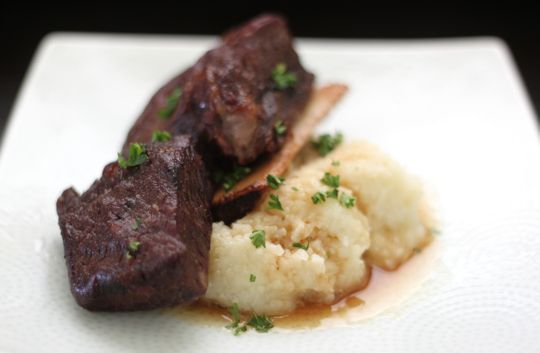 A pressure cooker just might be one of the most overlooked kitchen appliances for meat lovers. Want to cook a whole chicken and flavorful broth in less than an hour? Use a pressure cooker. Homemade beef stew in 30 minutes? No problem. Tender braised short ribs in an hour? Yes, please.
A pressure cooker just might be one of the most overlooked kitchen appliances for meat lovers. Want to cook a whole chicken and flavorful broth in less than an hour? Use a pressure cooker. Homemade beef stew in 30 minutes? No problem. Tender braised short ribs in an hour? Yes, please.
The short cooking time in a pressure cooker doesn’t sacrifice flavor or tenderness. Serve these pressure cooker short ribs next to short ribs that have been oven braised for three hours and no one will know the difference. The meat is so tender it’ll fall off the bone before your fork even gets near it. The flavor is rich and meaty, with subtle but enticing seasoning from ginger, garlic, allspice and cumin.
Whether it’s because you’re short on time, or don’t want the oven to heat up your kitchen all day, or you want an easy way to coax flavor and tenderness from less expensive cuts of meat, a pressure cooker is the answer. Modern pressure cookers are completely safe and with just a little practice, easy to use. Try this recipe for braised short ribs first, and you’ll be hooked.
Servings: 4
Time in the Kitchen: 1 hour
Ingredients:
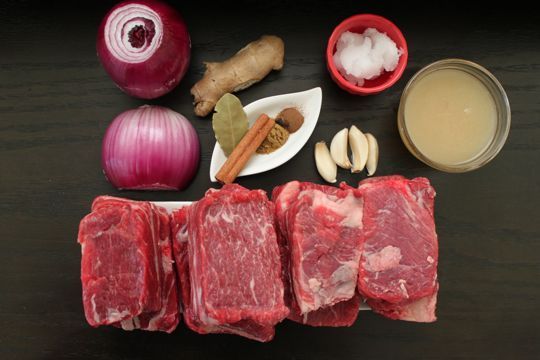
4 pounds bone-in beef short ribs, each about 2 to 3 inches (50 mm to 76 mm) long and thick, seasoned with salt and pepper (1.8 kg)
2 tablespoons coconut oil (30 ml)
1 1/2 red onions, coarsely chopped
4 garlic cloves, finely chopped
2-inch piece of ginger, finely chopped (50 mm)
1/4 teaspoon allspice (a pinch)
1/2 teaspoon cumin (2.5 ml)
3/4 cup beef broth (180 ml)
1/2 cup water (120ml)
1 clove
1 bay leaf
1 cinnamon stick
Finely chopped parsley or cilantro for garnish
Riced cauliflower on the side
Instructions:
Use a 6-quart or larger pressure cooker.
Heat the coconut oil in the pressure cooker (no lid) over medium high heat. Add the meat in batches, browning all sides of the ribs. Remove from the pressure cooker and set aside.
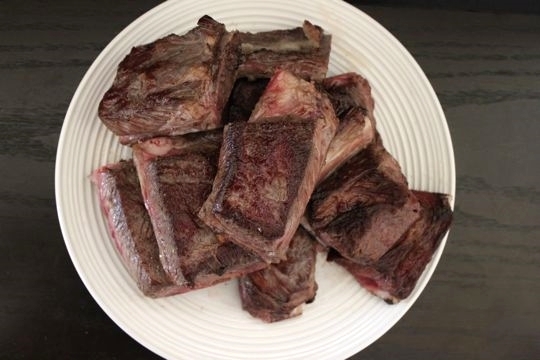
Add the onion, garlic and ginger. Sauté to soften the onion, 3 to 5 minutes. Add the allspice and cumin and mix well into the onion. Add the broth, water, clove, bay leaf and cinnamon stick. Stir up any bits of meat sticking to the bottom of the pot. Add the meat.
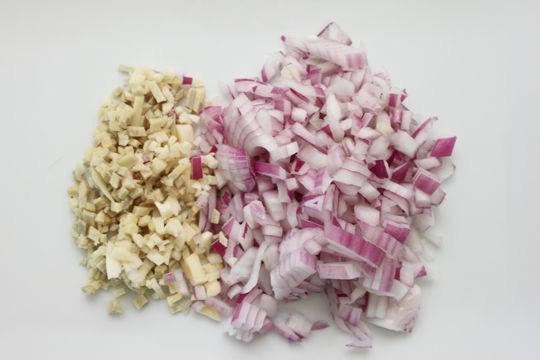
Click the lid into place on the pressure cooker, making sure it’s secure. Over high heat, bring the pressure cooker to high pressure. Reduce to medium high and cook for 35 minutes. Turn off the heat and let the pressure come down naturally.
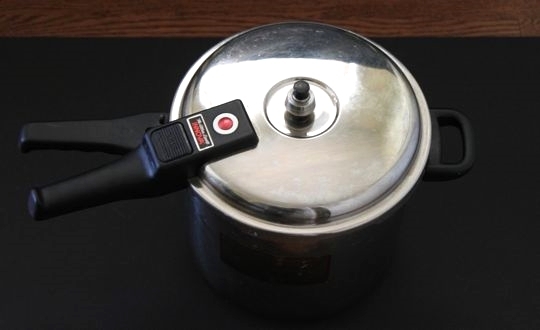
Carefully remove the lid.
Take the meat out.
Pour the liquid through a find mesh strainer, discarding the solids. Skim excess fat off the top of the liquid or use a fat separator. Simmer the liquid a few minutes to thicken, or to thicken further and balance out any saltiness whisk in whole cream.
Serve the sauce over the ribs and some vegetables (like roasted cauliflower or cauliflower rice). Garnish with parsley or cilantro.
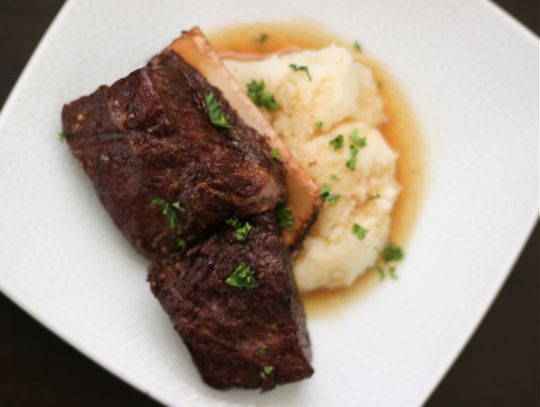
Not Sure What to Eat? Get the Primal Blueprint Meal Plan for Shopping Lists and Recipes Delivered Directly to Your Inbox Each Week




Mark Sisson's Blog
- Mark Sisson's profile
- 199 followers



